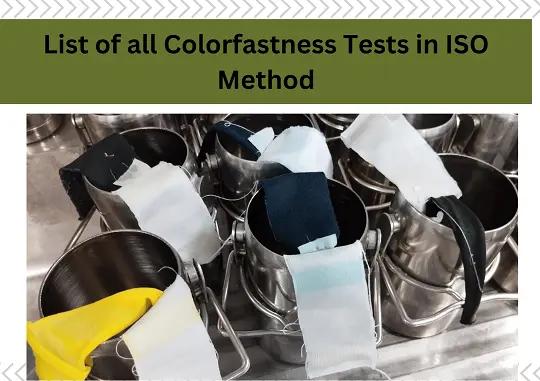List of all Colorfastness Test in ISO Method
The colorfastness test is the basic test for any Textile and Clothing item. If a manufacturer wants to export his goods to any popular retailer or buyer then testing of the product is mandatory. There are many types of textiles testing that are required for the shipment. It depends on the product type and category, fabric weight, dyeing procedure, fabric construction, etc. In this article, we explain a List of all Colorfastness Test in the ISO Method.
The most common tests required for any product according to buyer protocol or program manual are fiber test, flammability test, colorfastness test, physical test, dimensional stability, and appearance test, pH and formaldehyde test, restricted substances like lead, phthalate, azo dye test, etc.
In this article, will learn about all the colorfastness (ISO method) test names, methods, specimen sizes, and purposes.
Definition of Colorfastness
Colorfastness is the resistance of a textile material like fabric, yarn, trims, or accessories to change in any of its color characteristics, to transfer its color to any adjacent fabric or both, as a result of the exposure of the material to any environment that might be encountered during the processing, testing, storage or use of the material.

15 Types of Colorfastness Test Names in ISO Methods
Here is the top 15 list of colorfastness tests in the ISO method:
01. Colorfastness to Light: The colorfastness to light test method is ISO 105 X B02. Its specimen size in width wise is a minimum of 1 cm. But it may be wider or thinner depending on the testing sample. There is a total of six programs in this test method. They are method 1, method 2, method 3, method 4, method 5, and method 6. There is a total of 6 grades under these methods. But the most common programs are method 3: grade 4 (1st and 2nd exposures), method 2: grade 5 (1st exposure), method 3: grade 3 (1st exposure), etc.
Colorfastness to light test is done to determine the potential for a textile to fade when subjected to an artificial light source as a representative of sunlight.
02. Colorfastness to washing: The colorfastness to washing test method is ISO 105 X (C01, C02, C03, C04, C05). The specimen size is 10 cm X 4 cm.
03. Colorfastness to domestic and commercial laundering: This test method is ISO 105 X C06. The specimen size in this test method is 10 cm X 4 cm. There are many programs under this test method. But the most common programs are A2S 30, A2S 40, B2S 50, C2S 60, etc. In these common programs generally two chemicals are used. They are ECE phosphate reference detergent B (4g/1L) and sodium perborate tetrahydrate (1g/1L).
This test is done to determine the resistance of the color of textiles to domestic and commercial laundering procedures.
04. Colorfastness to domestic and commercial laundering (Oxidative bleach response using a non-phosphate reference detergent A): This test method is ISO 105 X C09. The specimen size in this test method is 10 cm X 4 cm. In this method, there is no need to use any multifibre to determine the staining. Because, through this test, we only check the color change of the tested specimen.
In this test method we need to use a total of three chemicals. They are ECE non-phosphate reference detergent A (10g/1L), Sodium perborate tetrahydrate (12g/1L), and the bleach activator tetra-acetylethylenediamine (TAED) 1.96g/1L.
05. Colorfastness to dry cleaning: The test method is ISO 105 X D01. The specimen size in this test method is 10 cm X 4 cm. In this test only one chemical is used and that is perchloroethylene.
06. Colorfastness to water: The test method is ISO 105 X E01. The specimen size in colorfastness to water test is 10 cm X 4 cm. Here only water is used but no chemical. Here, the adjacent multifibre may be DW or LW according to the buyer requirement.
This test is done to determine the resistance of the color of textiles to water.
07. Colorfastness to sea water: The test method is ISO 105 X E02. The specimen size in colorfastness to seawater test is 10 cm X 4 cm. In this test, salt is used (30g/L) with water.
This test is done to determine the resistance of the color of textiles to seawater.
08. Colorfastness to chlorinated pool water: The test method is ISO 105 X E03. The specimen size in colorfastness to pool water test is 10 cm X 4 cm.
This test is done to determine the resistance to chlorinated pool water of dyed, printed, or otherwise colored textile yarns and fabrics of all kinds.
09. Colorfastness to perspiration: The test method is ISO 105 X E04. The specimen size in colorfastness to perspiration test is 10 cm X 4 cm. This test is done in two mediums. One is acidic and another is alkaline. A total of three chemicals are used in this test method. They are sodium chloride, l – histidine mono-hydro chloride monohydrate, sodium dihydrogen orthophosphate dihydrate, and di-sodium hydrogen orthophosphate dodecahydrate.
This test is done to determine the resistance of colored textiles to the effect of human perspiration.
10. Colorfastness to burnt gas fumes: The test method is ISO 105 X G02. The specimen size in colorfastness to burnt gas fumes test is 10 cm X 3 cm. Normally one cycle is done in this test method. But the cycles can be 2 or more if the buyer requests.
This test is done to determine the resistance of colored textiles when exposed to atmospheric oxides of nitrogen as derived from the combustion of natural gas.
11. Colorfastness to ozone: The test method is ISO 105 X G03. The specimen size in colorfastness to ozone test is 10 cm X 5 cm. Normally one cycle (4.5 hrs) is done in this test method. But the cycles can be 2 or more if the buyer requests.
This test is done to determine the resistance of colored textiles to the action of ozone in the atmosphere at room temperature with relative humidities not exceeding 67%.
12. Colorfastness to bleaching – hypochlorite: The test method is ISO 105 X N01. The specimen size is 10 cm X 3 cm.
This test is done to determine the resistance of the color of textiles to hypochlorite bleach.
13. Colorfastness to bleaching – peroxide: The test method is ISO 105 X N02. The specimen size of bleaching–peroxide is 10 cm X 4 cm. Here DW multifibre is used to determine the color staining.
This test is done to determine the resistance of the color of textiles to peroxide bleach.
14. Colorfastness to Rubbing: The test method is ISO 105 X 12. In this test method, we have to do lengthwise and widthwise rubbing. One is dry and another is wet (wet pick up 95% to 100%).
This test is done for the determination of color transfer from the surface of colored textile materials to other surfaces by rubbing.
15. Colorfastness to phenolic yellowing: The test method is ISO 105 X 18. The specimen size of the phenolic yellowing test is 10 cm X 3 cm. It is done to assess the potential of phenolic yellowing of textile materials. This test duration is 16 hrs.


